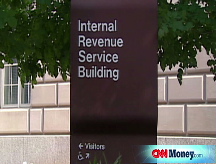Gearing up for the jobs report
Wall Street cuts losses at the end of Thursday's choppy session. Friday's focus is the December employment report.

NEW YORK (CNNMoney.com) -- Stocks seesawed Thursday on worries about the consumer after weak retail sales, and ahead of the December employment report which is expected to show massive job losses.
The Dow Jones industrial average (INDU) lost 0.3%. The Standard & Poor's 500 (SPX) index added 0.3% and the Nasdaq composite (COMP) gained 1.1%.
The Labor Department releases the December employment report Friday morning before the start of trade. Employers are expected to have cut 500,000 jobs from their payrolls after cutting 533,000 jobs in November, according to Briefing.com forecasts. The unemployment rate, generated by a separate survey, is expected to have risen to 7% from 6.7% in the previous month.
However, many economists think the actual numbers will be a lot higher than the forecasts. On Wednesday, payroll services firm ADP reported that the private sector shed 693,000 jobs in December. While the two reports are calculated differently, they both tend to forecast the same trend.
"The jobs report is going to be very weak," said Thomas Nyheim, portfolio manager at Christiana Bank & Trust. "The ADP report was far worse than expected and that tends to be almost a preliminary reading on the non-farm payrolls."
Nyheim said that the stock market will show a sharp knee-jerk reaction to the numbers, however they turn out. But longer term, he said, the reaction will be muted. "I don't think anyone is unaware that the labor market is hurting."
Thursday's market: Stocks slipped Wednesday and drifted Thursday as weak labor market reports and dour retail sales reports gave investors reasons to retreat after the recent rally.
But stocks recovered some Thursday afternoon after Democratic lawmakers said they've reached a deal with Citigroup to let bankruptcy judges change home loans in a bid to prevent foreclosures.
Still, that wasn't enough to overshadow job-market worries.
Stocks, demonstrated by the S&P 500, rallied 8% in less than two weeks through Monday's close, as part of a classic year-end rally. But investors have struggled to sustain those gains in the new year.
"We had the Santa Claus rally, but now everyone is returning to reality," said Kenny Landgraf, principal and founder at Kenjol Capital Management.
Landgraf said the combination of the weak retail sales, questions about the economic stimulus plan and jitters about Friday's jobs report were keeping stocks choppy. But stocks should drift higher over the next few weeks as more details of the stimulus plan are revealed.
"Bargain hunters are going to look at what was smashed last year and find things they want to buy," Landgraf said. He noted that recent info from tracking firm Trim Tabs suggests some people are putting money back into the market.
In the week ended Wed. Jan. 7, investors put roughly $6.4 billion back into equity mutual funds, Trim Tabs reported. It was only the third time since July that investors put money into stock funds, instead of withdrawing it. In the previous week, investors pulled $1.2 billion out of funds.
Obama: The president-elect made the case for his administration's $775 billion stimulus package Thursday morning, warning that failure to act could mean the recession lingers on for years. (Full story)
Sales slump: As expected, the nation's retailers reported dismal December sales as the recession continued to hit consumer spending. Many retailers also warned that quarterly results will decline as well.
Even Wal-Mart (WMT, Fortune 500), which has been thriving despite the recession, saw results that were shy of forecasts. The retailer said that stores open a year or more, a metric known as same-store sales, saw a 1.7% rise in December, excluding fuel. That was short of the 2.8% gain expected by analysts surveyed by Thomson Reuters. Wal-Mart slumped 7.5%.
Wal-Mart also warned that fourth-quarter results won't meet forecasts.
Among other companies, Sears Holdings (SHLD, Fortune 500) reported a 7.3% drop. However, the company also forecast that fiscal fourth-quarter earnings will top current estimates. Shares gained 23%.
Gap (GPS, Fortune 500) reported a 14% drop in same-store sales, which was worse than expected. The clothing retailer also said fourth-quarter profit will be worse than what analysts currently expect. Shares fell 4.7%.
A variety of oil, gold and other commodity stocks rallied, offsetting the losses. Tech gains made the Nasdaq the best-performing index.
Market breadth was positive. On the New York Stock Exchange, winners beat losers three to two on volume of 1.20 billion shares. On the Nasdaq, advancers beat decliners nine to five on volume of 2.03 billion shares.
Bonds: Treasury prices rose, lowering the yield on the benchmark 10-year note to 2.44% from 2.49% Wednesday. Treasury prices and yields move in opposite directions. Yields on the 2-year, 10-year and 30-year Treasurys all hit record lows last month.
Lending rates improved. The 3-month Libor rate fell to 1.35% from 1.40% Wednesday, according to Bloomberg.com. That marked a fresh 4 1/2 year low. Libor is a key bank lending rate.
Other markets: In global trading, Asian and European markets slipped.
In other overseas news, the Bank of England lowered its key interest rate by half a percentage point to 1.5%, the lowest level in the bank's history dating back to the late 17th century.
The dollar tumbled versus the euro and yen.
U.S. light crude oil for February delivery fell 93 cents to settle at $41.70 a barrel on the New York Mercantile Exchange after slumping 12% Wednesday.
COMEX gold for February delivery rose $12.80 to settle at $854.50 an ounce.
Gasoline prices rose 3.5 cents to a national average of $1.762 a gallon, according to a survey of credit-card swipes released Thursday by motorist group AAA.
Talkback: Have you tried to do a mortgage work-out? Was it successful or a failure? E-mail mailto:realstories@cnnmoney.com and your story could be included in an upcoming article. ![]()




